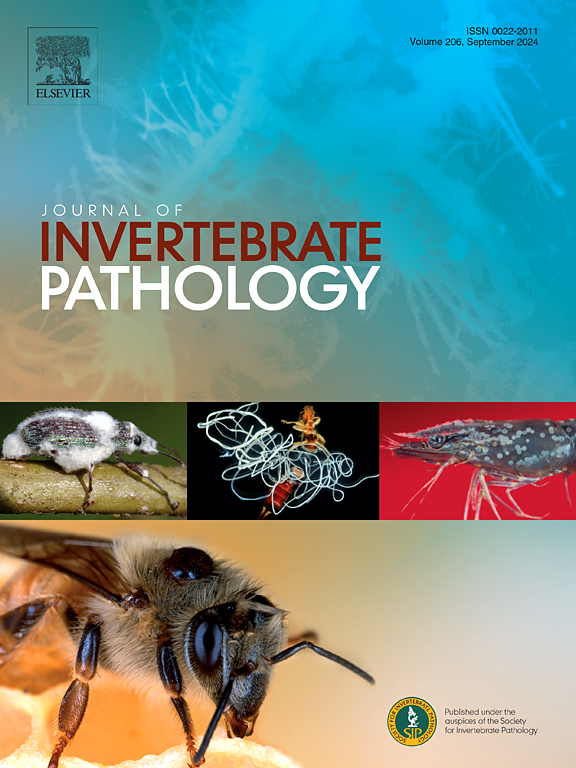Shell bacterial community dynamics suggest that American lobster (Homarus americanus) impoundment shell disease is caused by a dysbiosis
IF 2.4
3区 生物学
Q1 ZOOLOGY
引用次数: 0
Abstract
Impoundment shell disease (ISD) in the American lobster (Homarus americanus) is a distinct pathological condition from the more well-known epizootic shell disease. It is commonly observed at low prevalences in live American lobsters held overwinter in tidal pounds and significantly reduces their economic value. Impoundment shell disease was originally described in 1937; however, its etiology remains unclear. The main goal of this study was to characterize the bacterial community associated with ISD in Canadian lobsters. Lobsters were collected from a pound in southwest Nova Scotia, Canada, and the full 16S rRNA gene of bacterial communities from lesion and healthy shell areas of asymptomatic (As), moderately symptomatic (MS) and severely symptomatic (SS) animals was sequenced. Pielou evenness and Shannon diversity indexes of alpha-diversity were higher in healthy areas compared to lesion areas. Beta-diversity metrics indicate that the bacterial diversity differences are driven mainly by the relative abundance of a small number of bacteria, rather than the specific taxa present in the samples. Taxa were designated as being potentially involved with ISD based on their relative frequency, relative abundance or being core bacteriome in the lesion shell area. Among those found in this study, Tenacibaculum and Vibrio were previously described in ISD lesions; but others, such as Cellvibrionaceae, Polaribacter, Maribacter and Sulfitobacter were not. Altogether, the findings of this study indicate that ISD is driven by dysbiosis. Moreover, the inconsistency of taxa with previous studies may indicate that ISD consists of a combination of specific functional groups of bacteria, rather specific taxa.

壳菌群落动态表明美国龙虾(Homarus americanus)蓄水壳病是由生态失调引起的。
美洲龙虾(Homarus americanus)的蓄水壳病(ISD)是一种不同于众所周知的动物壳病的病理状况。通常在美国活龙虾中观察到低患病率,在潮汐磅中越冬,大大降低了它们的经济价值。蓄水壳病最初于1937年被描述;然而,其病因尚不清楚。本研究的主要目的是表征与加拿大龙虾ISD相关的细菌群落。从加拿大新斯科舍省西南部的一磅龙虾中收集龙虾,对无症状(As)、中度症状(MS)和严重症状(SS)动物的病变和健康壳区细菌群落的16S rRNA全基因进行了测序。健康区α -多样性的Pielou均匀度和Shannon多样性指数高于病变区。β -多样性指标表明,细菌多样性差异主要是由少数细菌的相对丰度驱动的,而不是由样品中存在的特定分类群驱动的。根据其相对频率、相对丰度或病变壳区的核心细菌群,将分类群确定为潜在参与ISD的分类群。在本研究中发现的这些细菌中,先前在ISD病变中描述过腱骨和弧菌;而Cellvibrionaceae、Polaribacter、Maribacter和Sulfitobacter则没有。总之,本研究的结果表明,ISD是由生态失调驱动的。此外,分类群与以往研究的不一致可能表明,ISD是由特定功能群的细菌组合而成,而不是特定的分类群。
本文章由计算机程序翻译,如有差异,请以英文原文为准。
求助全文
约1分钟内获得全文
求助全文
来源期刊
CiteScore
6.10
自引率
5.90%
发文量
94
审稿时长
1 months
期刊介绍:
The Journal of Invertebrate Pathology presents original research articles and notes on the induction and pathogenesis of diseases of invertebrates, including the suppression of diseases in beneficial species, and the use of diseases in controlling undesirable species. In addition, the journal publishes the results of physiological, morphological, genetic, immunological and ecological studies as related to the etiologic agents of diseases of invertebrates.
The Journal of Invertebrate Pathology is the adopted journal of the Society for Invertebrate Pathology, and is available to SIP members at a special reduced price.

 求助内容:
求助内容: 应助结果提醒方式:
应助结果提醒方式:


